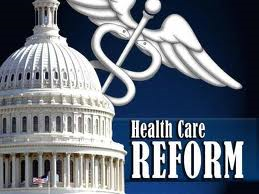 The Senate released its version (a.k.a. Better Care Reconciliation Act BCRA) of the House’s AHCA. Payers and providers adjust as needed because healthcare reforms, like BCRA, AHCA, and ACA, continuously move through state and federal legislatures. Today’s blog, pulls together summaries from numerous resources allowing you a quick glimpse or a deep dive into what waits around the corner.
The Senate released its version (a.k.a. Better Care Reconciliation Act BCRA) of the House’s AHCA. Payers and providers adjust as needed because healthcare reforms, like BCRA, AHCA, and ACA, continuously move through state and federal legislatures. Today’s blog, pulls together summaries from numerous resources allowing you a quick glimpse or a deep dive into what waits around the corner.
Becker’s Hospital Review gave the most concise item: “The Senate GOP’s Better Care Reconciliation Act draft, released June 22, could spark mixed credit implications for health insurers, according to Fitch Ratings.” Insurers and the Senate GOP healthcare bill: 6 things to know by Morgan Haefner.
Before looking at the winners and losers of BCRA, AHCA, and ACA, from various sources, here are three links comparing the entire House and Senate bills to the ACA in the cleanest, most interactive formats. These links deal with the basic facts of each aspect. The next sections summarizes the interpretations of winners and losers by various outlets.
BCRA, AHCA, ACA Full Comparisons
- Compare Proposals to Replace The Affordable Care Act by Kaiser Family Foundation
- CBO Scores the Senate Health Care Bill by Committee for a Responsible Federal Budget
- CHART: CBO Weighs Who Wins, Who Loses With Senate Health Care Bill by NPR
National Business Review
The NBR sees the biggest losers in the Senate plans are:
- Many of those who gained the most from Obamacare:
- Adults covered under Medicaid expansion: The Senate bill would maintain funding through 2020, but then make states pick up more of the tab, before cutting subsidies for the Obamacare expansion of the safety net program completely.
- Middle-income Obamacare enrollees: The Senate plans would cap tax credits for earnings making above 350 percent of the federal poverty level, or about $41,000 for an individual this year. After 2020, those middle-income earners would no longer get help with their premiums.
- Older adults: The Senate plan would roll back many of the advantages for older, sicker enrollees under Obamacare.
The Senate plan winners:
- Higher-income people would see through tax credits under the House plan, while preserving one of the ACA’s key protections:
- People with pre-existing conditions: The Senate plan takes out the House provision that would impose a premium surcharge on those who lapse in coverage.
- The working poor: The Senate plan fills in the gap left by Obamacare, extending tack credits for people earning less than federal poverty level ($11,700 this year) who have been shut out of the exchange market.
VOX Media
VOX Media “explains of news”. They see the BCRA this way.
Winners:
Pharma, medical device manufacturers, tanning salons, and more
- Families with $250,000 or more in income ($125,000 for singles).
- The [two taxes under consideration for repeal] Medicare surtax and the investment tax alone combine to a tax cut of $195,610 for the top 0.1 percent
Losers:
- Pregnant women and new mothers
- “This means that plans in the individual market could once again decide not to cover maternity care — like 88 percent of plans did before the Affordable Care Act passed,” as Vox’s Sarah Kliff explains.
- People in states that take a Medicaid “block grant,” who could see dramatic cuts in coverage
- Disabled people, elderly people, and everyone else who relies on Medicaid
Commonwealth Fund
In an article by David Blumenthal, M.D., ACA Repeal Would Devastate Already Struggling Rural Communities opines “…the health care cuts are a job killer—research from The Commonwealth Fund and George Washington University found that by 2026 the AHCA, if enacted, would cause nearly 1 million jobs to disappear. Health care jobs will be lost almost as soon as the law takes effect in Iowa, Kentucky, Maine, North Carolina, Ohio, West Virginia, and Wisconsin, among other states.”
“These cuts, especially to Medicaid, not only place the health care of rural children, the sick, the elderly, and people with disabilities at risk, they imperil the nursing homes, hospitals, and community organizations that serve these patients.”
Fitch Ratings
Fitch Ratings, in an article US Senate Bill A Risk for Governments, Health Providers, sees:
“Federal aid for Medicaid currently represents approximately 20% of all state budgets. The CBO estimates that the AHCA would lower federal Medicaid spending by 24% by fiscal 2026. The 2020 and 2021 implementation dates for most Medicaid provisions would likely result in pressure on states to cut funding to local governments, public colleges and universities, and healthcare providers.”
“Amongst healthcare providers, acute care hospitals would be the most pressured by those state cuts and by the rise in uninsured patients. The CBO estimates that the AHCA would raise the uninsured rate of the non-elderly segment of the US population to 19% from its current 10%. That change would mean hospitals would have a higher percentage of uninsured patients and lower patient volumes as people will opt out of less critical care. Unless offset by cost savings or higher reimbursement from insured patients, this would pressure margins and could result in downward ratings pressure.”
“In the near term, acute care hospitals and other healthcare providers would get a reprieve from the pressures of a decline in the number of insured people as the bill includes federal appropriation for approximately $7 billion (annually, through 2019) of cost-sharing subsidies for middle income enrollees to the individual health plan market. Healthcare companies would also benefit from the repeal of the taxes and fees imposed by the ACA.”
The Kaiser Family Foundation and Premium Changes
The KFF analyzed the claims data and created a spreadsheet of specific examples of potential rates changes in their article, Premiums under the Senate Better Care Reconciliation Act by Gary Claxton, Anthony Damico, Larry Levitt, and Cynthia Cox.
“Overall, marketplace enrollees would pay on average 74 percent more towards the premium for a benchmark silver plan in 2020 under the BCRA than under current law (see website article Table 1). Younger enrollees would see modest increases on average (10 percent for those under age 18; 17 percent for those ages 18 to 34), while average premiums would more than double for enrollees ages 55 to 64. State-level results are in website article Appendix Table 2.”






